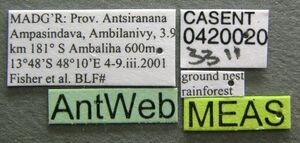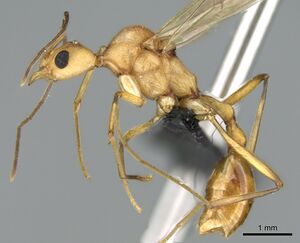Malagidris sofina
| Malagidris sofina | |
|---|---|

| |
| Scientific classification | |
| Kingdom: | Animalia |
| Phylum: | Arthropoda |
| Class: | Insecta |
| Order: | Hymenoptera |
| Family: | Formicidae |
| Subfamily: | Myrmicinae |
| Tribe: | Crematogastrini |
| Genus: | Malagidris |
| Species: | M. sofina |
| Binomial name | |
| Malagidris sofina Bolton & Fisher, 2014 | |
| At a Glance | • Ergatoid queen |
M. sofina nests in the ground or in rotten wood, and has been found in rainforest and montane rainforest, as well as in tropical dry forest. It forages mainly on the ground and in leaf litter, but also ascends low vegetation. Nests are often associated with steep clay or stone substrate and the entrance is an ear-like funnel that is sunk into a shallow alcove or raised above the rock surface. This specialized nesting behavior may function for gas exchange: projecting funnel entrances likely increase exchange rates for carbon dioxide and oxygen over sixfold compared to simple tubes (Helms et al., 2014). This nest structure is in part similar to the clay bank nesting Stenamma in Central America (Longino, 2005; Branstetter, 2013).
Identification
Bolton and Fisher (2014) - The worker of this species has the most attenuated scapes and femora in the genus. Its SI 201–231 and MfL/HW 2.81–3.13 are greater than in any other species, where the collective measurements are SI 97–192, and MfL/HW 1.25–2.76. The metafemur is extremely long and slender (MfL/MfH > 10.0) when compared to the other species (MfL/MfH collectively < 9.0). M. sofina is also the most lightly sculptured member of the genus, with the predominant sculpture of the dorsal mesosoma of dense reticulate-punctulation, rather than sharp rugae. The head capsule is strongly narrowed posteriorly, and cephalic pilosity is reduced compared to the other species; there is no posterior transverse row of 4–6 setae close to the posterior margin.
Keys including this Species
Distribution
Latitudinal Distribution Pattern
Latitudinal Range: -13.41666667° to -13.41666667°.
| North Temperate |
North Subtropical |
Tropical | South Subtropical |
South Temperate |
- Source: AntMaps
Distribution based on Regional Taxon Lists
Malagasy Region: Madagascar (type locality).
Distribution based on AntMaps
Distribution based on AntWeb specimens
Check data from AntWeb
Countries Occupied
| Number of countries occupied by this species based on AntWiki Regional Taxon Lists. In general, fewer countries occupied indicates a narrower range, while more countries indicates a more widespread species. |

|
Estimated Abundance
| Relative abundance based on number of AntMaps records per species (this species within the purple bar). Fewer records (to the left) indicates a less abundant/encountered species while more records (to the right) indicates more abundant/encountered species. |

|
Biology
Nesting Habits
M. sofina nests on cliff faces in natural rock alcoves or clay banks. Each nest has a funnel-shaped entrance that projects horizontally from the cliff face (Helms et al. 2014). A likely function is to increase gas exchange rates, and thus facilitate air flow within the nest.
Castes
Colonies have a single ergatoid queen and reproduce by fission, the latter allowing rapid construction of nests and funnel entrances. Colony size ranged from 16 to 127 workers with an average of 62.5 (± 34, n = 15 nests) (Helms et al. 2014).
Queen (ergatoid)
Images from AntWeb
   
| |
| Queen (ergatoid). Specimen code casent0420020. Photographer April Nobile, uploaded by California Academy of Sciences. | Owned by CAS, San Francisco, CA, USA. |
   
| |
| Queen (ergatoid). Specimen code casent0427881. Photographer April Nobile, uploaded by California Academy of Sciences. | Owned by CAS, San Francisco, CA, USA. |
Worker
Images from AntWeb
   
| |
| Holotype of Malagidris sofina. Worker. Specimen code casent0427840. Photographer Michele Esposito, uploaded by California Academy of Sciences. | Owned by CAS, San Francisco, CA, USA. |
   
| |
| Worker. Specimen code casent0427880. Photographer April Nobile, uploaded by California Academy of Sciences. | Owned by CAS, San Francisco, CA, USA. |
Male
Images from AntWeb
     
| |
| Male (alate). Specimen code casent0906626. Photographer Estella Ortega, uploaded by California Academy of Sciences. | Owned by CAS, San Francisco, CA, USA. |
    
| |
| Male (alate). Specimen code casent0906627. Photographer Estella Ortega, uploaded by California Academy of Sciences. | Owned by CAS, San Francisco, CA, USA. |
Nomenclature
The following information is derived from Barry Bolton's Online Catalogue of the Ants of the World.
- sofina. Malagidris sofina Bolton & Fisher, 2014: 30, figs. 25-29 (w. ergatoid q. m.) MADAGASCAR.
- Type-material: holotype worker, 4 paratype workers, 2 paratype ergatoid queens.
- Type-locality: holotype Madagascar: Antsiranana, Nosy Be, Rés. Lokobe, 6.3 km. 112° Hellville, 30 m., 13°25’S, 48°20’E, 19-24.iii.2001, BLF 3488, ground nest, rainforest (Fisher, et al.); paratypes with same data.
- Type-depositories: CASC (holotype); BMNH, CASC (paratypes).
- Distribution: Madagascar.
Unless otherwise noted the text for the remainder of this section is reported from the publication that includes the original description.
Description
Worker
(holotype in parentheses). TL 5.5–7.8 (7.2), HL 1.27–1.66 (1.50), HW 0.74–1.00 (0.93), CI 56–62 (62), SL 1.56–2.24 (2.08), SI 201–231 (224), PW 0.63–0.85 (0.74), WL 1.76–2.40 (2.16) (16 measured).
Mandible with 10–12 teeth and denticles in total, finely longitudinally costulate. Median portion of clypeus evenly convex in profile, without a false anterior margin; median clypeal seta arises from just above midpoint of anterior margin, not from a tubercle at the midpoint of an elevated false anterior margin. Median portion of clypeus with a number of weak longitudinal rugulae which may be incomplete or broken. Scapes extremely long (SI > 200), with minute pubescence but lacking standing setae. Club segments of funiculus long and slender, much longer than broad. EL 0.19–0.28 (EL/HW 0.26–0.29), with 15–16 ommatidia in the longest row. With head in full-face view sides behind the eyes elongate and strongly convergent posteriorly (width across posterior margin < 0.60 × HW), without an angle between side and posterior margin; posterior margin transverse, the occipital carina distinct but not produced into a raised translucent cuticular flange. Dorsum of head finely longitudinally rugose, the rugae weakening and fading posteriorly; spaces between the rugae conspicuously reticulate-punctulate. Ventral surface of head with faint, superficial transverse costulae. Dorsum of mesosoma densely reticulate-punctulate, and with minute low rugulae that are disorganised on pronotum but predominantly transverse on propodeum. In dorsal view pronotum broadest behind the humeri, but the sides behind the humeri gradually increase in width and are not abruptly flared outward. Propodeal spines long (0.54–0.64), sometimes the spine extremely broad basally, occupying all of the declivity to immediately above the propodeal lobe. Propodeal declivity unsculptured. Side of mesosoma reticulate-punctulate, with scattered feeble rugulae. Metafemur very long and slender, MfL 2.15–3.04 (MfL/HW 2.81–3.20, MfL/MfH 10.24–12.29). Peduncle of petiole long and slender, downcurved in profile and with a small, dentiform anteroventral process. Subpetiolar process not followed by a cuticular crest along the mid-ventral surface of the peduncle. Petiole node in profile bluntly conical, not inclined anteriorly. In posterior view the sides of the petiole node converge dorsally to a narrowly rounded apex in smaller workers; but in larger workers the sides are shallowly convex in their lower halves, narrower and straighter in their dorsal halves, and terminate in a small dorsal peak or tubercle on each side; dorsal surface of node between the peaks shallowly concave. Petiole node with faint superficial punctulate sculpture. Postpetiole in profile convex dorsally, about 1.30–1.47 times longer than high; in dorsal view distinctly longer than broad; maximum dorsal width of postpetiole (ca 0.35–0.50) about equal to its height. Dorsum of postpetiole node finely reticulate-punctulate and sometimes with a few vestiges of minute rugulae. Extreme base of first gastral tergite minutely punctulate, without basigastral costulae or at most with only the faintest vestiges of costulae remaining; tergite otherwise unsculptured.
Pilosity: with head in full-face view the side, both in front of and behind the eye, without projecting setae; with head in profile the dorsum behind the highest point with 1–3 pairs of setae that are inclined anteriorly, mostly grouped around highest point of vertex, without a transverse row of setae in front of the posterior margin; pronotal dorsum usually without setae, but rarely with 1 small pair, very close to the mesonotal junction; mesonotum usually without setae but extremely rarely 1 pair present anteriorly, never with setae at the metanotal groove; propodeal dorsum lacks setae; ventral surface of metafemur lacks setae; petiole node with 0–1 pair of setae on its posterior face; postpetiole usually without setae dorsally, but rarely 1 pair present, postpetiole posteriorly with 1 pair; gaster with sparse short simple setae. Full adult colour yellow to slightly orange-yellow.
Queen
(gyne). Ergatoid. TL 7.0–7.8, HL 1.40–1.52, HW 0.97–1.00, CI 65–69, SL 1.56–1.86, SI 161–188, WL 1.94–2.08, MfL 2.08–2.40, MfL/HW 2.14–2.42, MfL/MfH 9.33–10.90 (5 measured). EL 0.26–0.28 (EL/HW 0.26–0.28). Propodeal spine length 0.47–0.56, but the spines stouter than in the worker. Postpetiole length 0.66–0.68, width 0.68–0.70, height 0.68–0.72. Most dimensions are within the worker ranges, but the head is shorter and broader, the scape is relatively shorter, and the metafemur is both absolutely and relatively slightly shorter. In general the ergatoid matches the worker description, but the mesonotum is more strongly developed and the postpetiole and gaster are distinctly more voluminous. Pilosity appears reduced from the worker condition. Of the two ergatoid paratypes one has a single pair of setae at the highest point of the vertex, the other lacks cephalic setae; both entirely lack setae from the dorsal mesosoma, petiole and postpetiole; the first gastral tergite is naked, or has setae only at the extreme posterior margin. Non-paratypic ergatoids have 0–2 pairs of setae on the cephalic dorsum, but otherwise match the paratypes. Ocelli variably developed: all three ocelli are obvious in some of the ergatoids, but in the others, including both paratype ergatoids, only a reduced median ocellus, or an ocellar pit, remains. Field dissections of ergatoid queens from Galoko revealed that ovaries were active and there was sperm in spermatheca (C. Peeters, unpublished).
Male
Mandible with 8–11 sharp teeth. CI 67–70, SI 77–80, MfL 1.96–2.16 (2 measured). First funicular segment of antenna only 0.23–0.26 × the length of the second segment. EL/HW 0.49–0.50. With head in profile the dorsal outline behind the posterior ocelli slopes down gradually to the occipital carina, the surface not vertical immediately behind the ocelli. With mesosoma in dorsal view the pronotum forms a visible anterior arc in front of the mesoscutum. Notauli absent. Peduncle of petiole with spiracles borne on low prominences, in dorsal view the width across them is distinctly less than the width across the node. Postpetiole in dorsal view 1.45–1.55 × longer than broad.
Type Material
Holotype worker (upper specimen of two on pin), Madagascar: Prov. Antsiranana, Nosy Be, Rés. Lokobe, 6.3 km. 112° ESE Hellville, 30m., 13°25’S, 48°20’E, 19–24.iii.2001, ground nest, rainforest, BLF 3488, CASENT0427840 (Fisher et al.) (California Academy of Sciences). Paratypes. 4 workers and 2 ergatoid queens with same data as holotype; one worker mounted below holotype, the others coded: 1 worker CASENT0427842; 2 workers CASENT0427889; 2 ergatoid queens CASENT0427841 (CASC, The Natural History Museum).
References
- Bolton, B. & Fisher, B.L. 2014. The Madagascan endemic myrmicine ants related to Eutetramorium (Hymenoptera: Formicidae): taxonomy of the genera Eutetramorium Emery, Malagidris nom. n., Myrmisaraka gen. n., Royidris gen. n., and Vitsika gen. n. Zootaxa. 3791:1–99 (doi:10.11646/zootaxa.3791.1.1).
- Cantone S. 2018. Winged Ants, The queen. Dichotomous key to genera of winged female ants in the World. The Wings of Ants: morphological and systematic relationships (self-published).
- Helms, J.A., Peeters, C. & Fisher, B.L. 2014. Funnels, gas exchange and cliff jumping: Natural history of the cliff dwelling ant Malagidris sofina. Insectes Sociaux 61: 357-365.
References based on Global Ant Biodiversity Informatics
- Bolton B., and B. L. Fisher. 2014. The Madagascan endemic myrmicine ants related to Eutetramorium (Hymenoptera: Formicidae): taxonomy of the genera Eutetramorium Emery, Malagidris nom. n., Myrmisaraka gen. n., Royidris gen. n., and Vitsika gen. n. Zootaxa 3791(1): 1-99.



